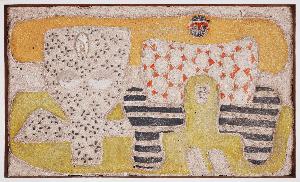Antine Nivola, Tino Nivola
Antine Nivola, Tino Nivola;Costantino Nivola
Place: Orani
Born: 1911
Death: 1988
Biography:
COSTANTINO NIVOLA, also known as Antine Nivola, Tino Nivola, was a renowned Italian sculptor, architectural sculptor, muralist, designer, and teacher. Born on July 5, 1911, in Orani, Sardinia, Nivola had already started his career when he fled Fascism for Paris in 1938, going to the U.S. in 1939.
Early Career
Nivola was born and grew up poor in Orani, a village in Sardinia. As an adolescent, he worked as an apprentice stonemason. In Sassari in 1926, Nivola served as apprentice to fellow painter Mario Delitala, executing frescoes for the aula magna of the local university. In 1931 Nivola enrolled in the ISIA (Istituto superiore per le industrie artistiche, the State Institute of Industrial Arts) in Monza. Through one of his teachers, the architect Giuseppe Pagano, he contributed work to the 1936 Milan Triennial VI and the Italian Pavilion at the 1937 Paris Exposition. This drew the attention of Adriano Olivetti, who named him art director of his company's Publicity Department, where Nivola "made a significant contribution to... 'the Olivetti style'.
United States
Nivola married fellow ISIA student Ruth Guggenheim in 1938, and left together for the United States via Paris in 1939. He established a home in Greenwich Village (first at Waverly Place, then at No. 47 West Eighth Street) to rebuild a social circle and a career despite speaking no English. Nivola resumed a close friendship with artist Saul Steinberg from Milan, attended meetings of the anti-fascist Italian-American Mazzini Society in 1941, and by the 1940s Nivola was presiding over a weekly gathering of artists at Del Pezzo's restaurant described by Peter Blake as comparable to the Algonquin Round Table. One key friendship was Le Corbusier. Introduced in 1945 by Josep Lluís Sert, Nivola became warm lifelong friends with the Swiss architect, his houseguest on Corbu's rare trips to America.
- Magazzino Italian Art (Cold Spring, United States) has several of Nivola's works, including Untitled made from cement.
- Costantino Nivola is also known for his abstract, large-scale architectural reliefs in concrete, made in his own sandcasting and cement carving processes.
- The Nivola Museum in Orani, Sardinia, is dedicated to his life and sculpture, and hosts the largest collection of his smaller scale work.
Nivola's career was marked by a series of successful projects, including a major commission for an interior wall in Olivetti's Fifth Avenue showroom in 1953. He executed it with a refined, scaled-up version of the beach process, in a sequence of panels. The resulting attention and publicity started a successful career in large-scale architecture work which lasted for decades. Important works by Nivola can be found on https://Wikioo.org, including Untitled (Magazzino Italian Art, Cold Spring, United States). More information about Nivola's life and work can be found on Wikipedia.

![Untitled [Study for the Olivetti Showroom, New York City, NY] Untitled [Study for the Olivetti Showroom, New York City, NY]](https://img.wikioo.org/ADC/art.nsf/get_small_image_wikioo?Open&ra=D8GANW)
![Untitled [Maquette for Morse and Stiles College, Yale University, New Haven, CT] Untitled [Maquette for Morse and Stiles College, Yale University, New Haven, CT]](https://img.wikioo.org/ADC/art.nsf/get_small_image_wikioo?Open&ra=D8GAN6)


![Untitled [Study for the Olivetti Showroom, New York City, NY] Untitled [Study for the Olivetti Showroom, New York City, NY]](https://img.wikioo.org/ADC/art.nsf/get_small_image_wikioo?Open&ra=D8GAN8)



![Untitled [Maquette for the Olivetti Showroom, New York City, NY] Untitled [Maquette for the Olivetti Showroom, New York City, NY]](https://img.wikioo.org/ADC/art.nsf/get_small_image_wikioo?Open&ra=D8GAKK)
![Untitled [Maquette for William E. Grady Vocational High School, Brooklyn, NY] Untitled [Maquette for William E. Grady Vocational High School, Brooklyn, NY]](https://img.wikioo.org/ADC/art.nsf/get_small_image_wikioo?Open&ra=D8GALC)
![Untitled [Maquette for the Continental Building, Philadelphia, PA] Untitled [Maquette for the Continental Building, Philadelphia, PA]](https://img.wikioo.org/ADC/art.nsf/get_small_image_wikioo?Open&ra=D8GALT)
![Untitled [Study for the Olivetti Showroom, New York City, NY] Untitled [Study for the Olivetti Showroom, New York City, NY]](https://img.wikioo.org/ADC/art.nsf/get_small_image_wikioo?Open&ra=D8GAMW)
![Untitled [Maquette for the Olivetti Showroom, New York City, NY] Untitled [Maquette for the Olivetti Showroom, New York City, NY]](https://img.wikioo.org/ADC/art.nsf/get_small_image_wikioo?Open&ra=D8GAMG)
![Untitled [Maquette for Bridgeport Post Newspaper Building, Bridgeport, CT] Untitled [Maquette for Bridgeport Post Newspaper Building, Bridgeport, CT]](https://img.wikioo.org/ADC/art.nsf/get_small_image_wikioo?Open&ra=D8GAME)